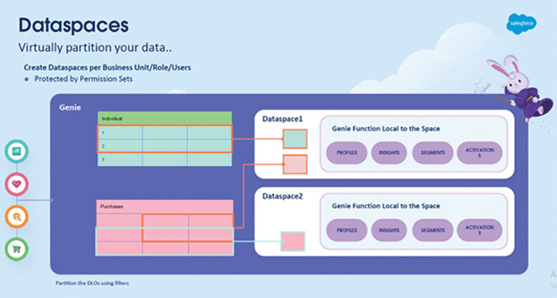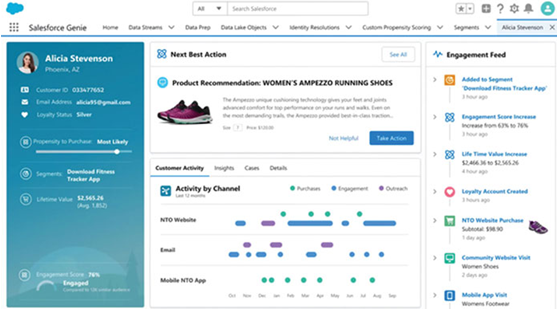Data spaces help to separate customer data from different business units logically. Data Spaces allow Admins to organize their real-time Data Cloud data into secure, logical spaces. So, different departments, with their different sets of customer data and use cases, can use the same Data Cloud instance (Figure 3.17).

Figure 3.17: Dataspaces enable virtual partition of data for different business units, users, and roles
- Harmonize
The next step is to harmonize the data to create a single repository of data and create customer graphs. Harmonization is required before stitching the different identities and creating a unique customer profile.
- Unify
Using matching rules and criteria, the different identities of a single customer are stitched together to create unique customer profiles. Each customer is then uniquely identified and all their interactions with the brand are consolidated in one consolidated view.
Salesforce helps to bring all the different customer interactions with a brand in a single view.

Figure 3.18: Salesforce Data Cloud brings all the customer interactions for a profile under one roof
- Analyze and predict
Once the single customer view is created, we can use the data to analyze the customer interactions and undertake predictive analysis. We can use Salesforce Einstein to generate insights like customer churn rate, likelihood to purchase, and so on. using built-in models. We can use the data in a BI tool to create reports and dashboards for analysis. With real-time data, you can create real-time predictions and analyses for your customer data. Understanding how your users are using your product or service is easier with real-time analytical data.
- Act
You can take actions on the real-time customer data by using it in Lightning actions, using the data inflows and journey maps, and so on. You can also use the data to enrich your first-party data sources. You can create audience segments and use the data on ad platforms like Meta, Google, and so on for efficient targeting and better ROI. Salesforce Data Cloud helps to connect with different outbound applications for marketing, advertising, analytics, and so on. You can export the data to different sources, like Databricks, for building your AI models.
In a nutshell, Data Cloud helps to bring all the customer data from different sources in real-time and create a single unique profile for each customer, which can then be used for marketing, analytics, data enrichment, and other business use cases.
